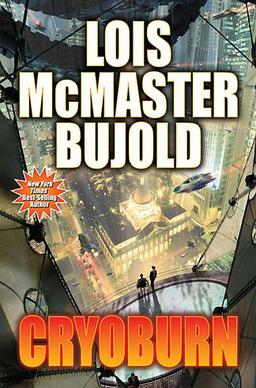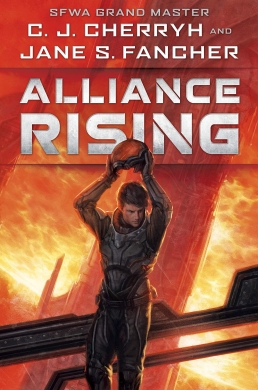Related Research Articles
John Barnes is an American science fiction author.

Saturn's Children is a 2008 science fiction novel by British author Charles Stross. Stross called it "a space opera and late-period [Robert A.] Heinlein tribute", specifically to Heinlein's 1982 novel Friday.

Cryoburn is a science fiction novel by American writer Lois McMaster Bujold, first published in October 2010. Part of the Vorkosigan Saga, it explores the long-term societal effects of cryonics. Bujold has called it "an extended meditation on death."

Zendegi is a science fiction novel by Australian author Greg Egan, first published in the United Kingdom by Gollancz in June 2010. It is set in Iran in the near future and deals with mapping the human brain, virtual reality and the democratization of Iran. The title of the book means "life" in Persian; the name of the virtual reality system featured in the story is Zendegi-ye Behtar, Persian for "better life".
Daybreak Zero is the title of a science fiction novel by John Barnes. It is the second of three books comprising the Daybreak series.

Ancillary Justice is a science fiction novel by the American writer Ann Leckie, published in 2013. It is Leckie's debut novel and the first in her Imperial Radch space opera trilogy, followed by Ancillary Sword (2014) and Ancillary Mercy (2015). The novel follows Breq—who is both the sole survivor of a starship destroyed by treachery and the vessel of that ship's artificial consciousness—as she seeks revenge against the ruler of her civilization. The cover art is by John Harris.

Jack Skillingstead is an American fiction writer living in Seattle, Washington.
The Last President is a science fiction novel by John Barnes. It is the third of the three books constituting the Daybreak series.

Alliance Rising: The Hinder Stars I is a 2019 science fiction novel by American writers C. J. Cherryh and Jane S. Fancher. It is one of Cherryh's Merchanter novels and is set in the author's Alliance–Union universe. It is the first new novel in this universe to be published in 10 years, the previous being Regenesis in 2009, and the first Merchanter novel in 22 years, the previous being Finity's End in 1997. Alliance Rising is the first book in The Hinder Stars series, and is the first science fiction collaboration between Cherryh and her partner, Fancher. The second book, Alliance Unbound, is due to be published in October 2024. Alliance Rising takes place in the early Alliance–Union timeline, before the events in Downbelow Station (1981) and the founding of the Merchanter's Alliance.
AnnaLinden Weller, better known under her pen name Arkady Martine, is an American author of science fiction literature. Her first novels A Memory Called Empire (2019) and A Desolation Called Peace (2021), which form the Teixcalaan series, each won the Hugo Award for Best Novel.

The Final Architecture is a series of science fiction novels by British writer Adrian Tchaikovsky. It contains the books Shards of Earth, Eyes of the Void, and Lords of Uncreation. The series focuses on a group of humans fighting against the mysterious Architects, who destroy inhabited planets. The series has been well-received critically, with Shards of Earth winning the 2021 BSFA Award for Best Novel.
Dark Integers and Other Stories is a collection of five science-fiction short stories by Australian writer Greg Egan, published on 25 March 2008 by Subterranean Press. One of them, "Oceanic", won the Hugo Award for Best Novella, while two others were nominated.
"Luminous" is a science-fiction short story by Australian writer Greg Egan, first published in Asimov’s Science Fiction in September 1995.
"Dark Integers" is a science-fiction short story by Australian writer Greg Egan, first published in Asimov's Science Fiction in October/November 2007. The short story was included in the collections Dark Integers and Other Stories in 2008, Oceanic in 2009 and The Best of Greg Egan in 2020. It was nominated for the Hugo Award for Best Novelette in 2008. It is a sequel to the short story "Luminous".
"Reasons to Be Cheerful" is a science-fiction short story by Australian writer Greg Egan, first published in Interzone 118 in April of 1997. The short story was included in the collections Luminous in 1998 and The Best of Greg Egan in 2020.
"Appropriate Love" is a science-fiction short story by Australian writer Greg Egan, first published in Interzone #50 in August 1991. The short story was included in the collection Axiomatic in 1995 and The Best of Greg Egan in 2019.
"Chaff" is a science-fiction novelette by Australian writer Greg Egan, first published in Interzone #78 in December 1993. The novelette was included in the anthology The Year’s Best Science Fiction: Eleventh Annual Collection edited by Gardner Dozois in 1994 and in the collections Our Lady of Chernobyl in 1995, Luminous in 1998 and The Best of Greg Egan in 2019.
"Into Darkness" is a science-fiction novelette by Australian writer Greg Egan, first published in Asimov's Science Fiction in January 1992. The novelette was included in the collections Axiomatic in 1995 and The Best of Greg Egan in 2019.
"Unstable Orbits in the Space of Lies" is a science-fiction short story by Australian writer Greg Egan, first published in Interzone #61 in July 1992. The short story was included in the collections Axiomatic in 1995 and The Best of Greg Egan in 2019.

Creation Node is a 2023 science fiction novel by British writer Stephen Baxter, first published in September 2023 in the United Kindom by Victor Gollancz Ltd. The book is about the discovery of the hypothesised Planet Nine in the Oort cloud at the outer edge of the Solar System. Initially it is thought to be a black hole, but it is later revealed to be an artificial planet.
References
- ↑ "Directive 51". Publishers Weekly . Retrieved 21 September 2024.
- ↑ Letson, Russell (11 July 2010). "Russell Letson reviews John Barnes". Locus . Retrieved 21 September 2024.
- ↑ Jennings, Kelly (17 May 2010). "Directive 51 by John Barnes". Strange Horizons . Retrieved 21 September 2024.